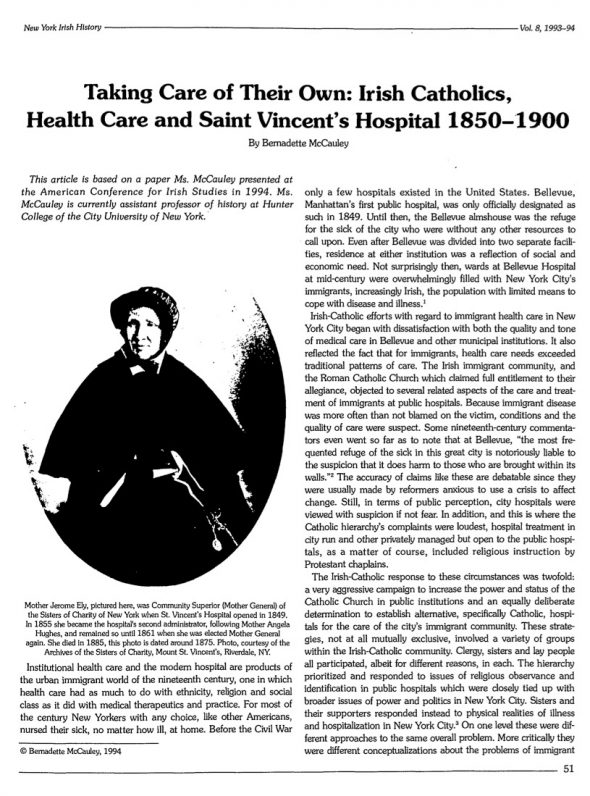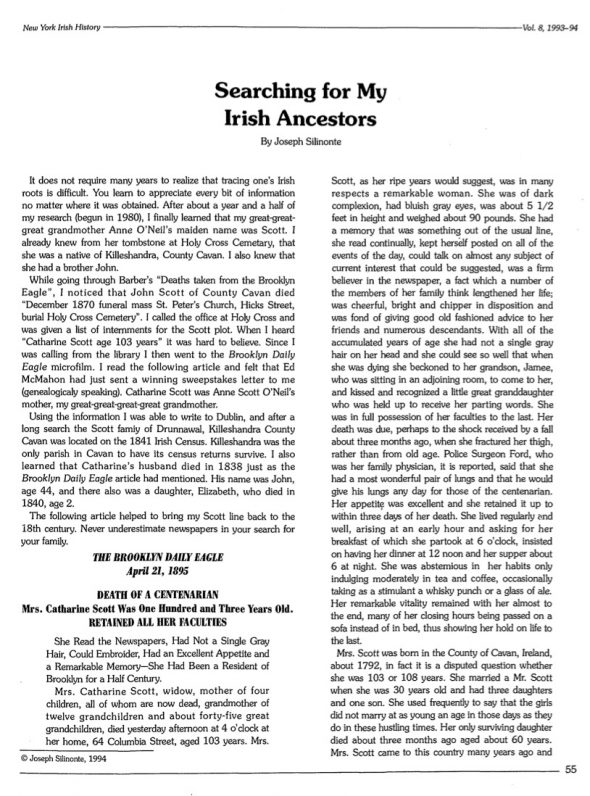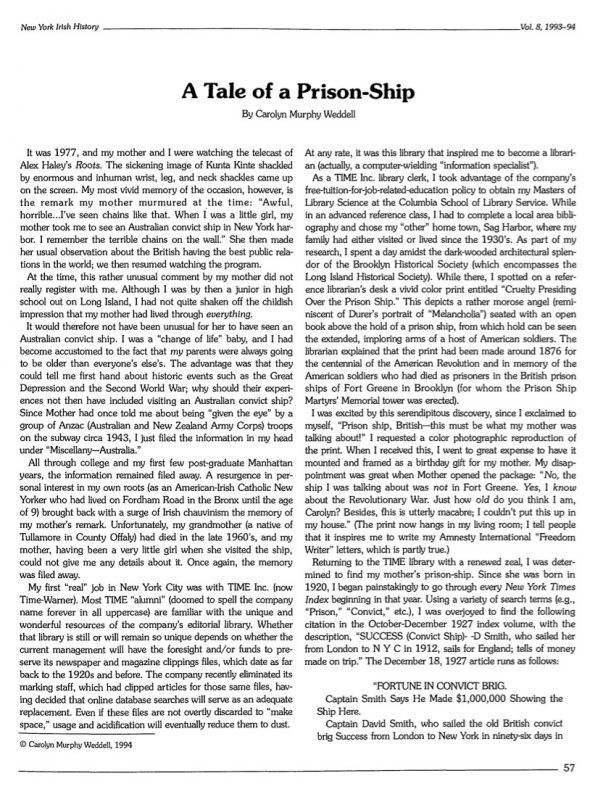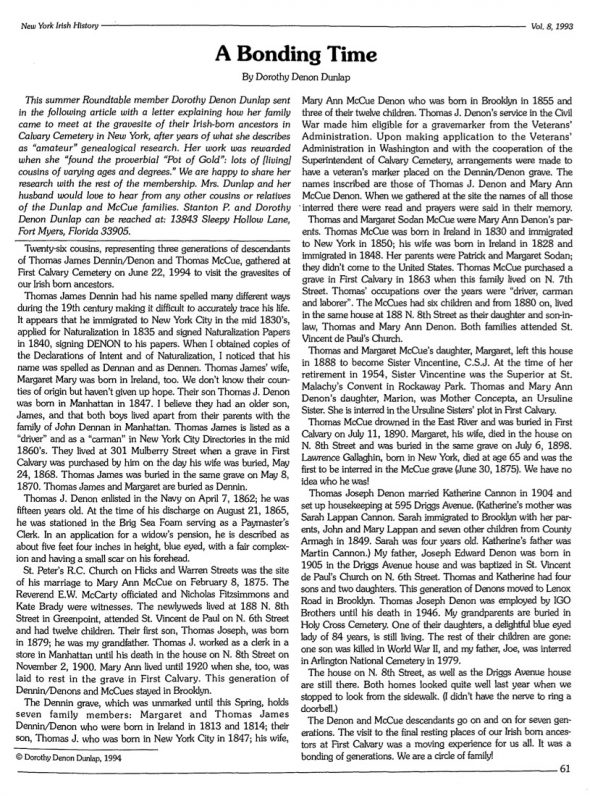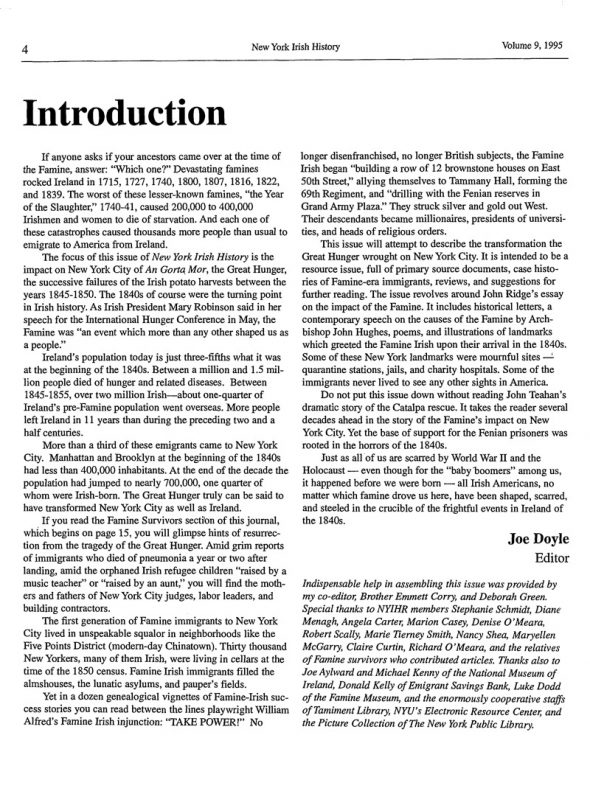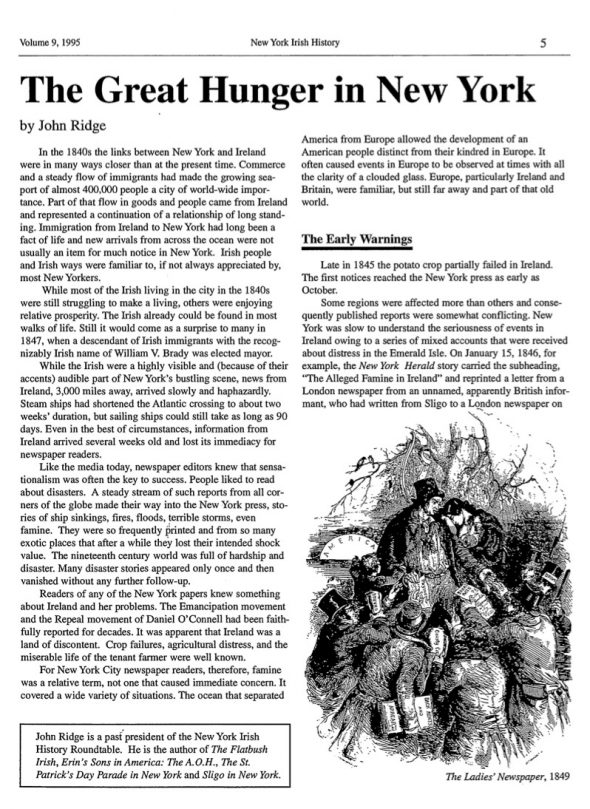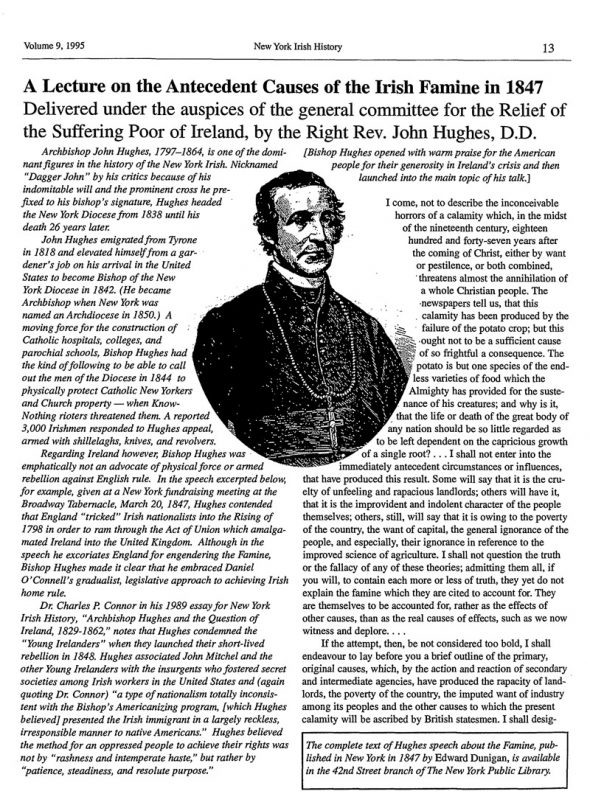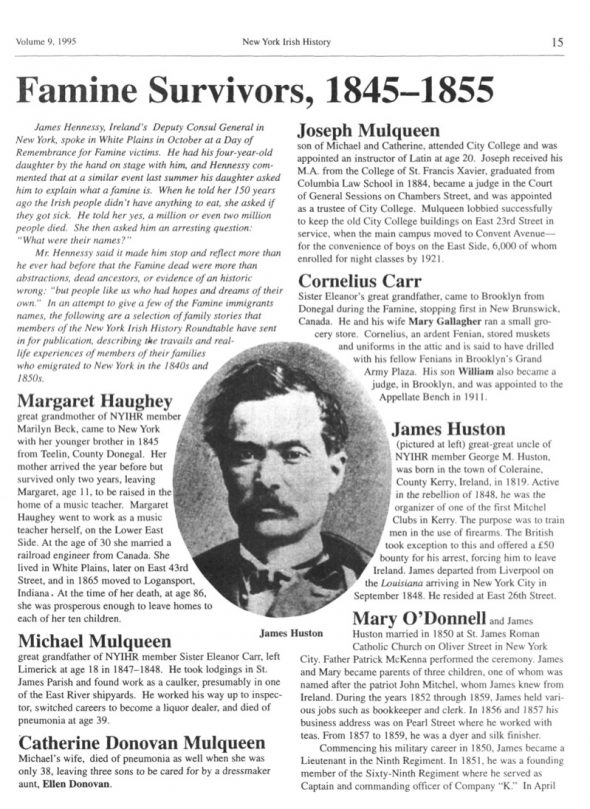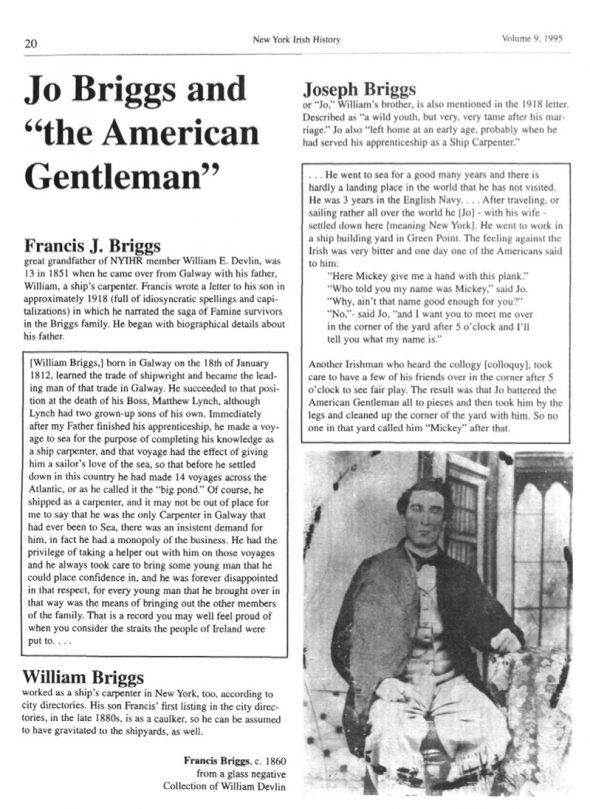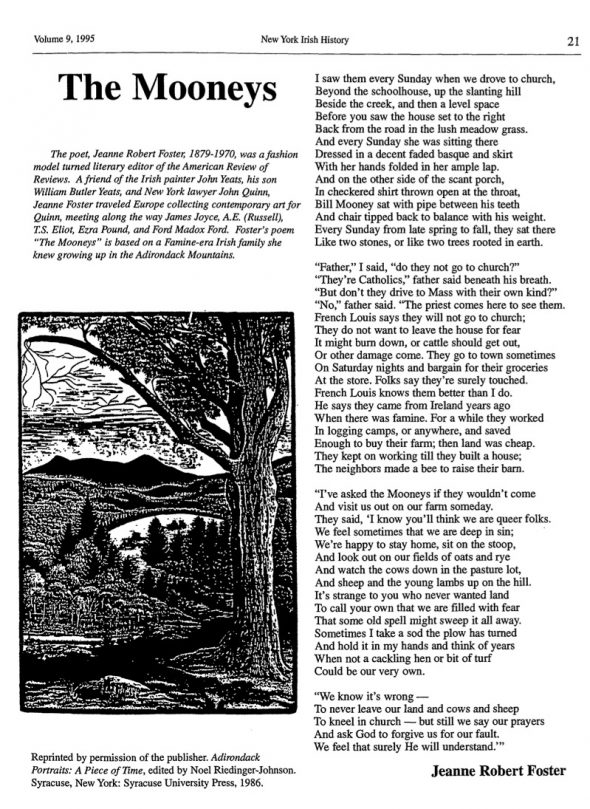New York Irish History Roundtable - Journal Articles
Taking Care of Their Own - Irish Catholics, Health Care and Saint Vincents Hospital 1850-1900
Author: Bernadette McCauley
Publication Year: 1993-94
Journal Volume: 08
Article Reference: NYIHR-V08-08
Mother Jerome Ely, pictured here, was Community Superior (Mother General) of the Sisters of Charity of New York when St. Vincent's Hospital opened in 1849. In 1855 she became the hospital's second administrator, following Mother Angela Hughes, and remained so until 1861 when she was elected Mother General again. She died in 1885, this photo is dated around 1875. Photo, courtesy of the Archives of the Sisters of Charity, Mount St. Vincent's, Riverdale, NY. Institutional health care and the modern hospital are products of the urban immigrant... [Read Full Article]
Searching for My Irish Ancestors
Author: Joseph Silinonte
Publication Year: 1993-94
Journal Volume: 08
Article Reference: NYIHR-V08-09
It does not require many years to realize that tracing one's Irish roots is difficult. You learn to appreciate every bit of information no matter where it was obtained. After about a year and a half of my research (begun in 1980), I finally learned that my great-greatgreat grandmother Anne O'Neil's maiden name was Scott. I already knew from her tombstone at Holy Cross Cemetary, that she was a native of Killeshandra, County Cavan. I also knew that she had a brother John.
While going through Barber's "Deaths taken from the Brooklyn... [Read Full Article]
A Tale of a Prison-Ship
Author: Carolyn Murphy Weddell
Publication Year: 1993-94
Journal Volume: 08
Article Reference: NYIHR-V08-10
It was 1977, and my mother and I were watching the telecast of Alex Haley's Roots. The sickening image of Kunta Kinte shackled by enormous and inhuman wrist, leg, and neck shackles came up on the screen. My most vivid memory of the occasion, however, is the remark my mother murmured at the time: "Awful, horrible...I've seen chains like that. When I was a little girl, my mother took me to see an Australian convict ship in New York harbor. I remember the terrible chains on the wall." She then made her usual observation about the British... [Read Full Article]
A Bonding Time
Author: Dorothy Denon Dunlap
Publication Year: 1993-94
Journal Volume: 08
Article Reference: NYIHR-V08-11
This summer Roundtable member Dorothy Denon Dunlap sent in the following article with a letter explaining how her family came to meet at the gravesite of their Irish-born ancestors in Calvary Cemetery in New York, after years of what she describes as "amateur" genealogical research. Her work was rewarded when she "found the proverbial "Pot of Gold": lots of [living] cousins of varying ages and degrees." We are happy to share her research with the rest of the membership. Mrs. Dunlap and her husband would love to hear from any other cousins... [Read Full Article]
Introduction
Author: Joe Doyle
Publication Year: 1995
Journal Volume: 09
Article Reference: NYIHR-V09-01
If anyone asks if your ancestors came over at the time of the Famine, answer: "Which one?" Devastating famines rocked Ireland in 1715, 1727, 1740, 1800,1807, 1816, 1822, and 1839. The worst of these lesser-known famines, "the Year of the Slaughter," 1740-41, caused 200,000 to 400,000 Irishmen and women to die of starvation. And each one of these catastrophes caused thousands more people than usual to emigrate to America from Ireland.
The focus of this issue of New York Irish History is the impact on New York City of An Gortq Mor, the... [Read Full Article]
The Great Hunger in New York
Author: John Ridge
Publication Year: 1995
Journal Volume: 09
Article Reference: NYIHR-V09-02
In the 1840s the links between New York and Ireland were in many ways closer than at the present time. Commerce and a steady flow of immigrants had made the growing seaport of almost 400,000 people a city of world-wide importance. Part of that flow in goods and people came from Ireland and represented a continuation of a relationship of long standing. Immigration from Ireland to New York had long been a fact of life and new arrivals from across the ocean were not usually an item for much notice in New York. Irish people and Irish ways were... [Read Full Article]
A Lecture on the Antecedent Causes of the Irish Famine in 1847
Author: Right Rev. John Hughes, D.D.
Publication Year: 1995
Journal Volume: 09
Article Reference: NYIHR-V09-03
A Lecture on the Antecedent Causes of the Irish Famine in 1847 Delivered under the auspices of the general committee for the Relief of the Suffering Poor of Ireland, by the Right Rev. John Hughes, D.D. Archbishop John Hughes, 1797-1864, is one of the dominant figures in the history of the New York Irish. Nicknamed "Dagger John" by his critics because of his indomitable will and the prominent cross he prefixed to his bishop's signature, Hughes headed the New York Diocese from 1838 until his death 26 years later.
John Hughes emigrated... [Read Full Article]
Famine Survivors, 1845-1855
Author: New York Irish History Roundtable
Publication Year: 1995
Journal Volume: 09
Article Reference: NYIHR-V09-04
15 Famine Survivors, 1845-1855 James Hennessy, Ireland's Deputy Consul General in New York, spoke in White Plains in October at a Day of Remembrance for Famine victims. He had his four-year-old daughter by the hand on stage with him, and Hennessy commented that at a similar event last summer his daughter asked him to explain what a famine is. When he told her 150 years ago the Irish people didn 't have anything to eat, she asked if they got sick. He told her yes, a million or even two million people died. She then asked him an arresting... [Read Full Article]
Jo Briggs and the American Gentleman
Author: New York Irish History Roundtable
Publication Year: 1995
Journal Volume: 09
Article Reference: NYIHR-V09-05
Jo Briggs and "the American Gentleman" Francis J. Briggs great grandfather of NYIHR member William E. Devlin, was 13 in 1851 when he came over from Galway with his father, William, a ship's carpenter. Francis wrote a letter to his son in approximately 1918 (full of idiosyncratic spellings and capitalizations) in which he narrated the saga of Famine survivors in the Briggs family. He began with biographical details about his father. [William Briggs,] born in Galway on the 18th of January 1812, learned the trade of shipwright and became the... [Read Full Article]
The Mooneys
Author: Jeanne Robert Foster
Publication Year: 1995
Journal Volume: 09
Article Reference: NYIHR-V09-06
The poet, Jeanne Robert Foster, 1879-1970, was a fashion model turned literary editor of the American Review of Reviews. A friend of the Irish painter John Yeats, his son William Butler Yeats, and New York lawyer John Quinn, Jeanne Foster traveled Europe collecting contemporary art for Quinn, meeting along the way James Joyce, A.E. (Russell), T.S. Eliot, Ezra Pound, and Ford Madox Ford. Foster's poem "The Mooneys" is based on a Famine-era Irish family she knew growing up in the Adirondack Mountains.
Reprinted by permission of the... [Read Full Article]

